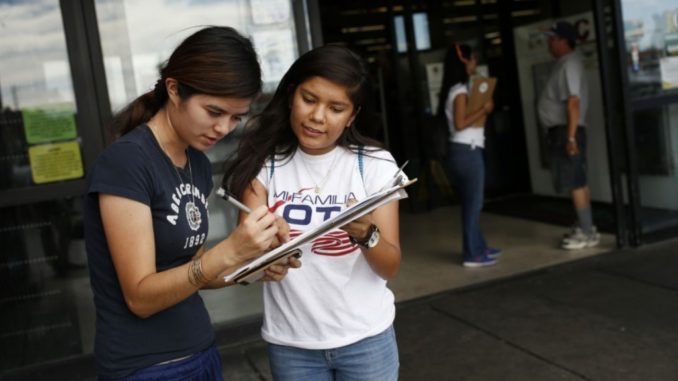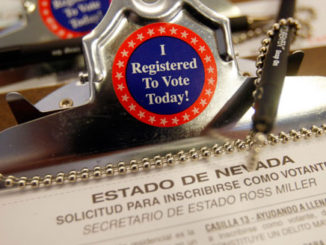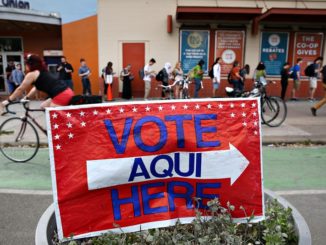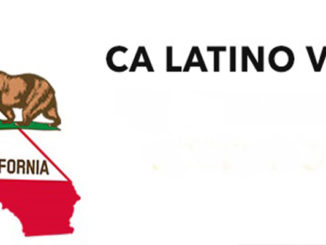
by Ali A. Valenzuela and Melissa Michelson
Donald Trump and Hillary Clinton are both talking about reaching out to Latino voters, but are they doing what it takes to get Latinos out to vote in November? Should their outreach specifically target Latinos as Latinos, or should their get-out-the-vote (GOTV) messages instead appeal to everybody simply as Americans?
Our research, forthcoming in the American Political Science Review, shows that both kinds of messages can increase Latino voter turnout — although each succeeds for different segments of the Latino community. Latino U.S. citizens with strong attachments to their ethnic community respond to messages that refer to their Latino identity. Latinos with weak ethnic attachments respond instead to appeals to their American identity.
Here’s how we investigated this
Historically, candidates and campaigns have gotten their people to the polls by appealing to their group identities, and race and ethnicity in particular have long been used in candidate messaging and campaign strategies. But how well do these messages work, and for which kinds of voters?
We asked these questions using two randomized field experiments with Latino voters: one in Los Angeles County, Calif., conducted in 2010, and another in Hidalgo County, Tex., in 2012. In each experiment, we recruited subjects from adjacent communities that had overwhelmingly Latino populations (over 75 percent) that reinforce and strengthen Latinos’ ethnic attachments.
To figure out which Latinos within these communities had strong or weak ethnic identities, we looked at their neighborhood’s average household income; whether they were born in the United States or elsewhere; their most commonly used language; and how many years they’d been registered to vote. We expected Latinos with strong ethnic identities to come from lower-income communities or to be immigrants who primarily spoke Spanish and had been registered to vote for a few years or less.
Conversely, we expected Latinos who lived in better-off communities and who tended to have more contact with non-Latinos, who primarily spoke English, who were born inside the United States, and who had been registered to vote for several years or more to be just as strongly attached to their American identity as they were to their ethnic identity.
Registered Latino voters then received a live telephone call that encouraged them to vote. They were randomly assigned to hear one of three different messages.
In one message, which we called “Latino identity,” subjects were told that the call was coming from the “Latino Voter Project,” was part of a campaign to turn out “Latino voters,” and was designed to make the “Latino community heard.” (In Texas, we replaced “Latino” with the more commonly used “Hispanic.”)
In another message, which we called “American identity,” Latino voters heard the same message — except that the organization was called the “American Voter Project,” and it was trying to turn out “American voters” to make the “American community heard.”
We also included a “placebo” message about recycling that we used as a baseline for comparing our effects.
After each election, we obtained official voting records from the county registrars to see who in the treatment and control groups actually turned out to vote.
Here’s what we found
In the California experiment, voters who were appealed to with the “Latino” message were 7.2 percentage points more likely to vote than those who heard the recycling message. Voters who were appealed to with the “American” message were 4.9 percentage points more likely to vote.
So both appeals worked in the overwhelmingly Latino communities where we tested them — but they weren’t equally effective with everyone. In the graphs below, we show how each message worked for those who lived in well-off or impoverished communities; for those who were more or less culturally assimilated; and for those who had been registered to vote recently or for a longer amount of time. The bars represent the effects of the ethnic (Latino/Hispanic) and national (American) identity messages compared with the recycling message.
As we’d predicted, for Latino citizens who lived in well-off communities, who were culturally assimilated, and who were politically engaged, either appeal to vote worked, whether it referred to their identity as “Latino” or as “American.”
But only the Latino appeal increased voting among Latino citizens from poorer communities, who weren’t as fully assimilated, or who hadn’t been voting for as long.
Our findings in Texas were similar.
These results are similar to what other scholars have found: Latinos and others with strong group identities respond better when those identities are implicated in politics. That’s true, for example, for ethnic or racial minorities who live in majority-minority districts or near fellow group members; those who can vote for a candidate or representative with the same ethnic or racial identity; or when there’s a political issue salient to the group on the ballot. Our work has added the insight that, for Latino U.S. citizens, political messages referring to their ethnic identity can help get out the vote — especially among those who are strongly identified with their ethnicity.
But it’s important to notice in our results that not all Latinos identify equally strongly with their ethnic group. We focused on those who lived in ethnic enclaves, where ethnic attachments are strong, and found ethnic appeals consistently increased turnout. But even there, the better-assimilated Latinos responded just as well to an appeal based on their American identity. Those working to get voters to the polls would do well to target their appeals judiciously.
Ali A. Valenzuela is assistant professor of politics at Princeton University. Find him on Twitter @AliAValenzuela.
Melissa R. Michelson is professor of political science at Menlo College. Find her on Twitter @profmichelson.




